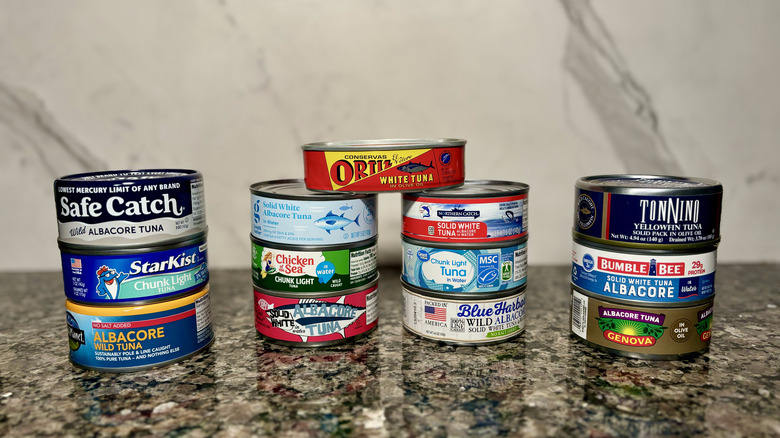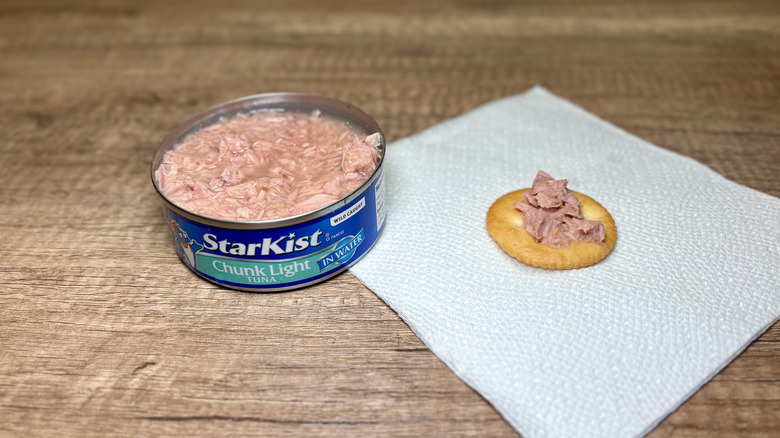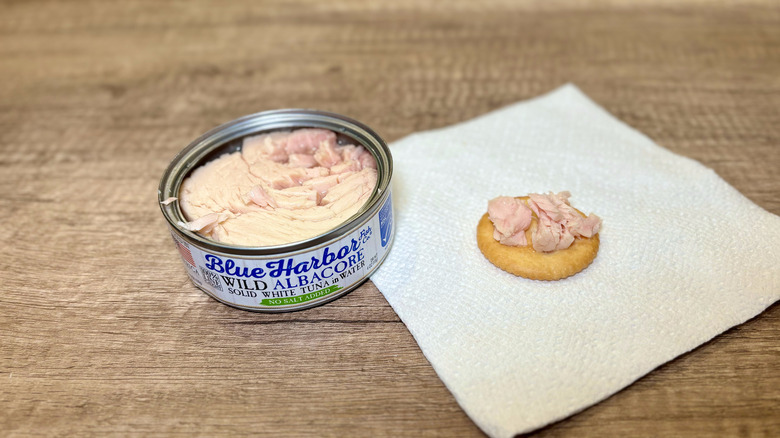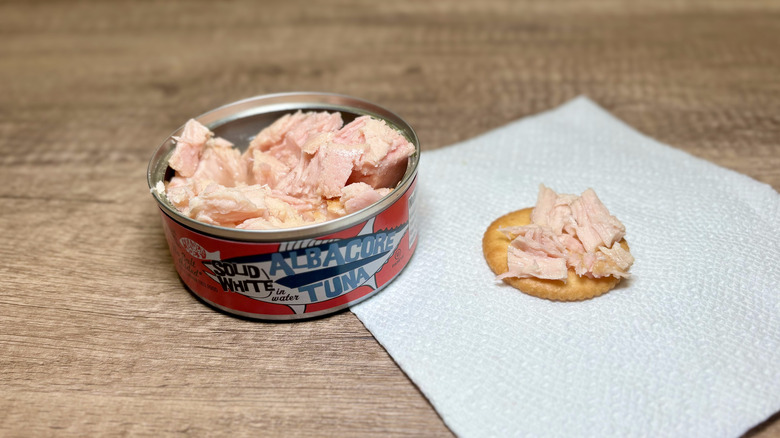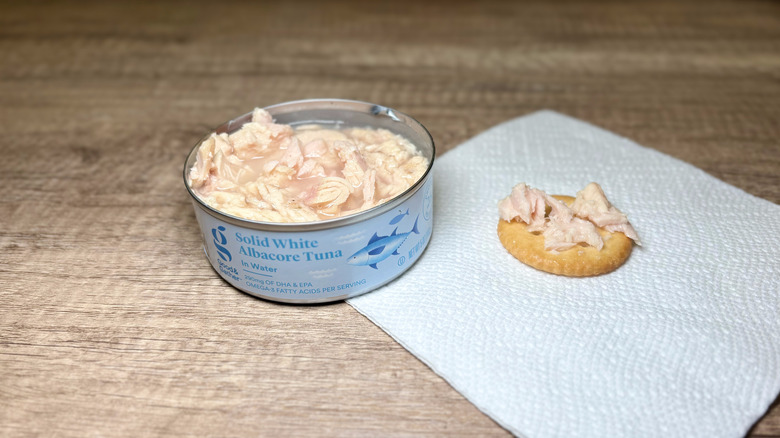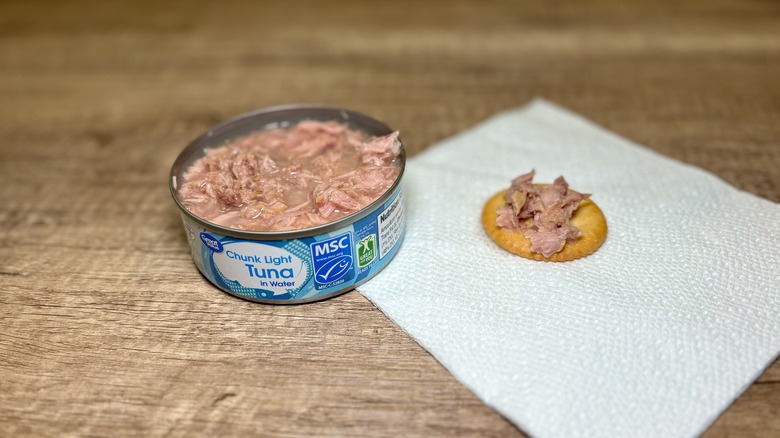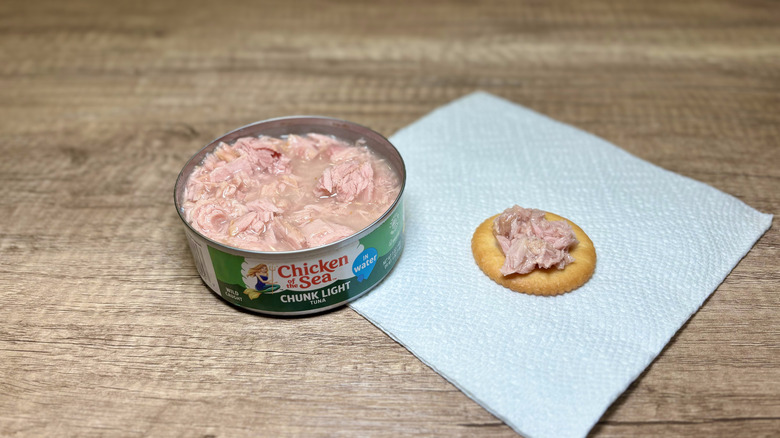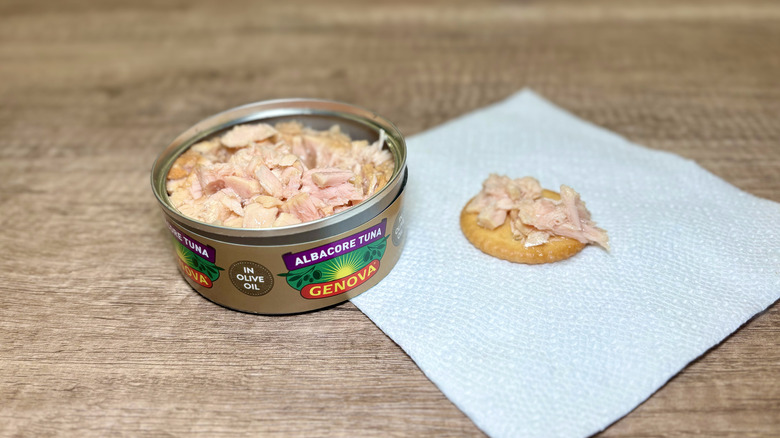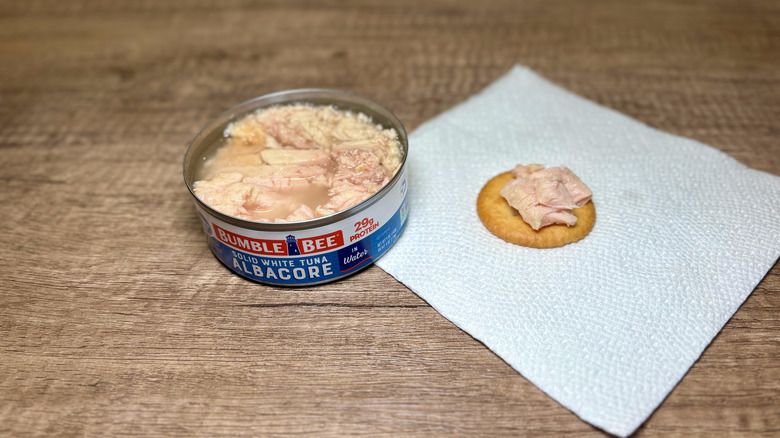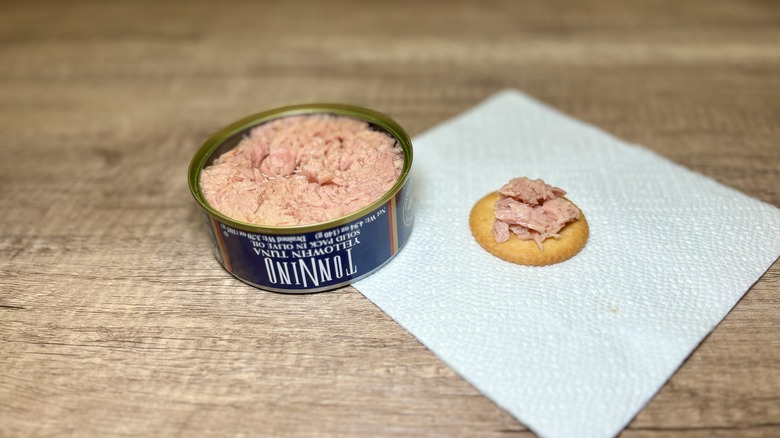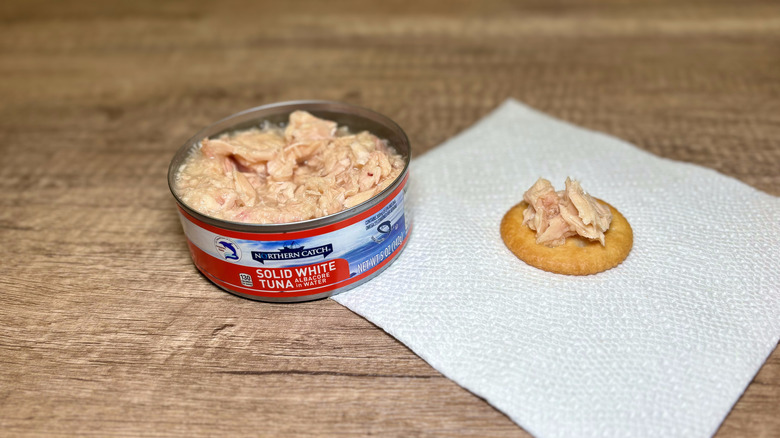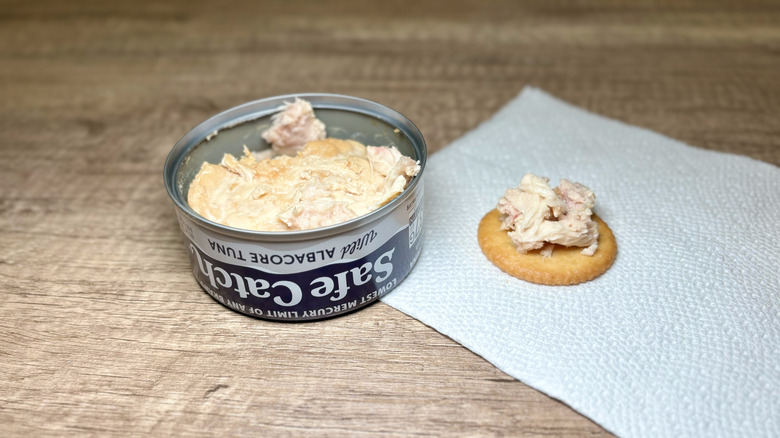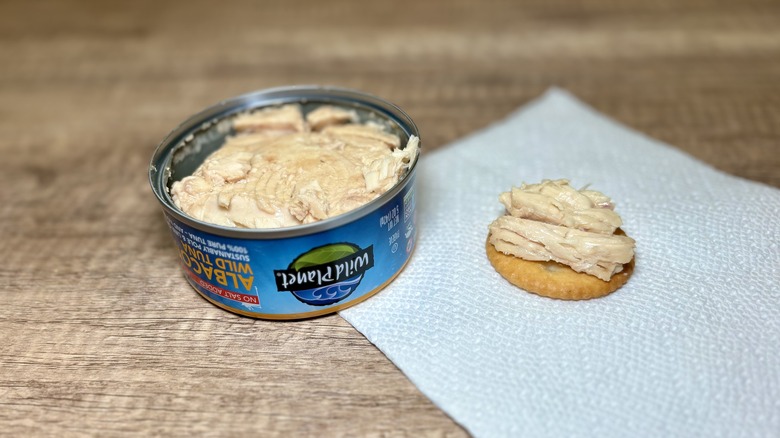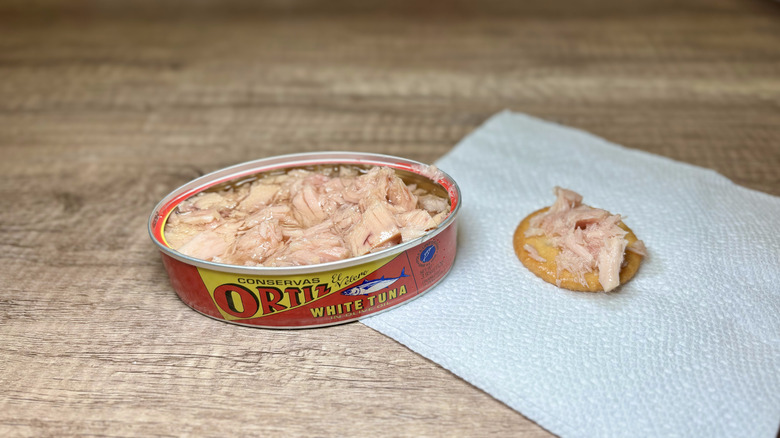The Ultimate Ranking Of Canned Tuna Brands
Growing up, I was a Jessica Simpson fan. Her song "I Wanna Love You Forever" was my ringtone for a period of time. I know — ringtones. Yikes! Anyway, in that phase of my life, I watched a little reality show called "Newlyweds: Nick and Jessica." It followed Jessica Simpson and her husband, Nick Lachey, through their first few years of married life. Though their marriage wouldn't last, one pop culture famous moment would. The scene went down like this: While enjoying a bit of tuna and confused by the label on the tin, Simpson wondered aloud whether what she was eating was chicken or fish. It have Chicken of the Sea brand its very own moment, and it's one I kept thinking of while working on this ranking.
Though Chicken of the Sea is probably the brand I was most familiar with before sampling, I really expected there to not be too much difference between canned tuna brands. Tinned seafood is having a moment, but canned tuna is canned tuna, right? I wondered if sampling and differentiating these would be difficult. It turns out each can was very different, and the gap between the lowest ranked tuna and the highest is nothing short of dramatic. To get the most accurate measures of each, I completed a blind taste test and ultimately rated each tuna brand on texture, taste, and fishing practices.
13. StarKist
When I looked at the range of StarKist products, with snack kits and multiple kinds of tuna offered, I imagined that the variety indicated a solid tasting fish. However, in my taste test, I found this simply not to be the case. In fact, I couldn't even finish a small bite of this tuna. The flavor was overwhelmingly fishy. As a kid, I spent many summer trips fishing for bullhead in Wisconsin, and the smell of that cleaning shack came rushing back to me with one bite, and not in a positively nostalgic way. Possibly even worse was that the texture of this fish was mushy. The tasting experience led to a low ranking.
In terms of fishing practices, the StarKist can has a note that the fish inside was wild caught and dolphin safe, but I couldn't find any other indicators as to how the fish is actually caught. Though StarKist was the first company to have that dolphin safe moniker in 1990, in today's grocery aisle, I didn't see a single can without it. All told, I wished there was some other indication or information of how the fish was harvested rather than a vague "wild caught" label.
12. Blue Harbor
While StarKist had so much fishy flavor that it would surely have called my childhood cat from another room, the canned tuna from Blue Harbor had very little flavor. The taste was so faint that I didn't have much to rate. Instead, I was left with a texture score to contend with, and this wasn't much better than the blandness that pervaded. What stood out was a grittiness that felt like dampened sandpaper.
On the other hand, Blue Harbor did get high marks for its fishing practices. The can label boasts that the albacore tuna was line caught, and that comes proudly accompanied by the Marine Stewardship Council (MSC) label. This designation is an accreditation that companies work toward. It means that the brand got its fish in a way that had minimal environmental impact and from a fish stock that was considered sustainable.
While it was great to see these sustainability and ethical designations on a can of tuna, they just didn't adequately compensate for the lack of flavor and the overall texture. These reasons are why, even with these positives in place, I ranked Blue Harbor so low overall.
11. Trader Joe's
Similar to Blue Harbor's fish, the tuna from Trader Joe's offered little tuna flavor with a texture that was better than mush, but not enough to get it far from a low ranking. As for selection, since it is Trader Joe's, there were only a few options. I had to choose between salt or no salt added Albacore tuna, or a packet of wild Skipjack tuna.
Interestingly, Trader Joe's canned tuna used different fishing practices for the different varieties of fish. The Albacore variety was fished using a circle hook with nylon leads, while the Skipjack was wild caught without Fish Aggregating Devices (FADs). I also found that Trader Joe's claims that the Skipjack was "the only tuna on the market for which each fish is tested individually for mercury. Only those fish registering 0.15 parts per million of mercury or less are used."
While this number was impressive, it wasn't the only tuna on the market tested in this fashion since Safe Catch hit the scene. These factors are interesting, and certainly help environmentally conscious consumers make an informed decision, but I just couldn't get past the lackluster flavor: the reason Trader Joe's appears so low on this list.
10. Good & Gather
Like many brands, Good & Gather had a rather mixed bag when it came to its fishing information. Some of the tuna (chunk light) did not have an MSC icon on it, but the Albacore tuna did. Like the rest, each can had the dolphin safe label, but the consistency wasn't there for the MSC accreditation.
For flavor, the tuna had a deep brininess that made it feel overly salty, and the texture was more on the mushy side but not as egregious as what came out of StarKist's can. While I enjoyed the flavor of Trader Joe's more than this one, it was only slight, and the edge was only eclipsed by the MSC aspect credited to a few of Good & Gather's products. The fact that the Skipjack was caught via pole and line really helped push it up too. The "pole and line" phrasing is one of the easiest ways to tell that the fish was caught in a way that protects other sea life. Of course, if the flavor were even better, I would have ranked it higher.
9. Great Value
I found it confusing that some brands had inconsistent designations placed on labels, where certain fish had a label while others were missing it. I supposed this happened when certain fish types had earned the designation through fishing practices but others had not. However, Walmart's house brand, Great Value, didn't suffer from this confusion. Rather, each can had the MSC label prominently displayed.
I placed this one mostly in the middle of the range for texture. It had a somewhat stringy feel to it, not like lumped fish or even little slices of fish, but rather, stringiness that you might get from shredded chicken. The flavor ranked lower, a basic, bland tuna flavor that was double-edged in that it didn't do much to stand out.
While this wasn't my first choice in terms of a basic store brand, I did give it the edge over Good & Gather because the flavor was certainly better. For options, Great Value offers canned tuna and tuna pouches which make for an interesting and convenient variety of products.
8. Chicken of the Sea
In the blind taste test, I noted that it tasted like the tuna I remember from my childhood. Chicken of the Sea was the default brand I ate as a kid in my macaroni and cheese and the brand I most remember gracing our pantry. While shopping, I was surprised to find that it was a little difficult to find in stores, as it was everywhere when I was much younger.
In any case, this one scored, overall, in the middle of the pack. The flavor was exactly what I expected canned tuna to taste like, and the texture was slightly chunky rather than stringy, mushy, or dry. It didn't blow me away, but it was easily edible.
Also of note, Chicken of the Sea has its own Initiative Program called SeaChange. Producer Thai Union Group uses this initiative across its brands, which also include Genova tuna. Though it remains a little unclear how exactly this program impacts Chicken of the Sea specifically, according to a sustainability report from 2022, across Thai Union Group's brands, 28% of fisheries were MSC certified, 13% were in the assessment phase, 40% were working towards Fishery Improvement Project (FIP) status. FIP is a process that asks fisheries to make more sustainable choices. 19% did not fall into either category. Between flavor, texture, and fishing practices, this brand falls easily within the middle of these brands.
7. Genova
As Thai Union Group's other tuna company, Genova also had the SeaChange badge, so its products were most certainly factored into the same numbers that Chicken of the Sea shared. In fact, I found the flavor of Chicken of the Sea and Genova to be similar, though Genova had a slightly more salty offering.
Something distinctive about the Genova brand was that most of its tuna options were in Olive oil. Rather than an even packing mix between water and olive oil, Genova leaned heavily into olive oil territory with eight of the offered products in olive oil and two of them packed in water.
Since the brand clearly specializes in olive oil packing, I sampled an offering that was packed in olive oil. I sampled a simple olive oil option, but there are flavor infused olive oil packing options like lemon and Herbes de Provence, Calabrian chili, and garlic and Tuscan herbs. You can also go for options in extra-virgin olive oil.
6. Bumble Bee
While some of the tuna brands had a shredded texture or a mixture of shreds and chunks, Bumble Bee brand's canned tuna all felt to be large, square hunks of tuna. The feel was agreeable, but I found it to be on the dry side; it needed extra moisture to be more palatable. However, I was more impressed with this flavor than I expected it to be, and it was lighter and more fresh than the lower ranked brands in beat out. From this point on in the rankings, the canned tuna brands all followed Bumble Bee in that they could have been a restaurant quality serving, if prepared correctly in a tuna pasta, or Niçoise salad. However, Bumble Bee still reminded me of canned tuna.
In terms of noteworthy fishing information or designations, Bumble Bee is labeled with the MSC, wild caught, and dolphin safe logos. However, not all the tuna in the Bumble Bee brand had the same labeling. For a higher ranking, I definitely preferred to see more consistency in the fishing information.
5. TonNino
Throughout my tasting, there were a few brands that just seemed to take things to a restaurant-quality, main course flavor. TonNino definitely fit the bill in this case. It was meaty and popped with umami, slightly moist but not damp. Although I chose not to rank this one at the tip top, it warranted placement as a top five favorite.
TonNino was among a few tuna brands that had an unconventionally opened can. This sort of thing actually added a certain je ne sais quoi to the brand. The easy open pull tab wasn't located at the top. Rather, it was at the bottom, so when I opened it up and took a picture, the whole thing appeared upside down.
The label on TonNino one noted that it was wild caught and dolphin safe with a lower level of mercury, but there was no indication of exactly how the fish was wild caught. Unfortunately, this missing information brought TonNino down from the top of my list. The flavor definitely made it one of my top options, but the lack of easy-to-find information or noteworthy accreditations beyond just being dolphin safe made this one not quite as high in the overall ranking.
4. Northern Catch
I love Aldi as much as the next deal shopper, but I've never considered it to be an ultra superior brand to some of the other offerings you can get at grocery stores. However, Northern Catch tuna from Aldi certainly flew in the face of this incorrect perception. Although the can had nothing noteworthy on it about the fishing method — other than the expected wild caught, dolphin safe notations — Northern Catch was easily towards the top of my ranking due to taste and texture.
For flavor and texture, I gave Northern Catch the highest marks possible. I got an almost sweet quality to the overall flavor. It tasted like the kind of fish I might get at a fine dining restaurant that specializes in cooking tuna in new and interesting ways. It was fresh, reminiscent of a sea breeze rather than the dirty below-deck of a boat. The only aspect that dragged this one down was a lack of information about the brand's fishing practices.
3. Safe Catch
As a "Shark Tank" fan, I was eager to try a bite of Safe Catch tuna. I remember watching the company try to catch a deal in the tank and wondered whether the tuna tasted different from other brands.
The big draw of Safe Catch is that the brand tests every fish for its mercury level, and only those with exceptionally low mercury levels get canned. Safe Catch follows restrictions that are two and a half to ten times more strict than what the FDA requires. Trader Joe's is no longer the only company testing each individual fish. Interestingly enough, Safe Catch also claims that it's the only brand that tests every fish. Clearly, for brands that devote time to this testing, ensuring the customer knows about it is an essential component of the brand's marketing.
The MSC and mercury labels, combined with the flavorful fish and deep moisture level, made this tuna one of the favorites I sampled. However, there was an odd texture to the fish when I first opened the can that I didn't expect. The effect made the tuna look more like a solid tuna cake rather than tuna filets.
2. Wild Planet
Each time I examined a new can of tune, I wanted to see a notation of how the fish was caught. Unfortunately, I didn't often get it. However, Wild Planet was very specific on this point, with the phrase pole and line caught right on the can. Other fishing practices can be so destructive. So, it was always significant when I saw a company that was so specific. I discovered that if a brand went the extra mile to ensure this extra care in fishing, it would be noted on the can somehow.
Like others at the higher level of canned tuna, the fish tasted pure, though this one did have more of a fishy quality than I expected. It wasn't putrid or rancid like some of the lesser tasting tunas, but maybe just a bit more ... wild. In fact, this extra fishiness was the sole reason this tuna didn't swim away with the top spot. Unfortunately for Wild Planet, the flavor of Ortiz was just better, though, not by much.
1. Ortiz
If you live near a World Market but have never been, you may very well be sleeping on an excellent grocery option. With sections devoted to international brands, you can find favorites from around the world all under one roof. Here, I found Ortiz tuna.
This variety of tuna, like Wild Planet, is hook and line caught and got the highest ranking I could give in flavor and texture. Ortiz explains that it uses a seasonal approach. Fisherman catch the white tuna fish variety (also called Thunnus alalunga or longfin tuna) at the best time of year, which just so happens to span from July through October. I found it to be exceptionally tasty, with an element that would separate your tuna salad from a regular lunch into something gourmet. The texture was dense, with something to dig your teeth into, and enjoyable if not a little drier than I might expect having grown up with less worldly canned tuna.
Methodology
In order to aid the unseen aspect of this taste-testing, my husband was an absolute asset in this ranking. We approached this with all the gravitas his science minded brain musters. As I set up, plated, and photographed each tuna, he numbered a separate scoop, keeping track of each brand's location before placing them in order on a platter.
Then, I blindly tasted each, giving the tuna two scores: Texture (out of three) and flavor (out of five). To ensure I got the tuna on its own without any undue salty affect from the cracker, I sampled a little piece of each tuna on its own, as well as at least one bite of a cracker. After he revealed which tuna were which brands, I added an additional score (out of two) dependent on research of each company's process when it came to harvesting, sustainability initiatives, and the brand mission to keep tuna fishing possible for generations to come.
